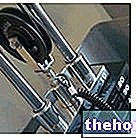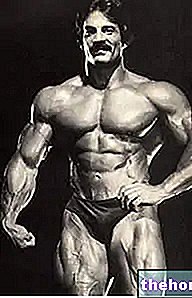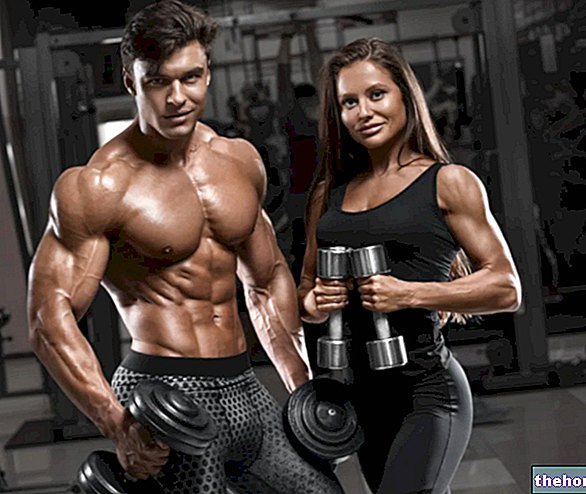Muscle strength is the ability of the human machine to face all those situations in which it is necessary to overcome a resistance or oppose it.

Compared to the past, in modern sport there are no activities that do not include training aimed at improving strength capacity, most of the time through the use of overloads; the latter, sometimes even unjustly criticized, are the most suitable means of " increase in strength and muscle mass.
Force classifications
- Maximum or pure: maximum expression of force that the neuromuscular system is able to express with a voluntary contraction (prevalence of load at the expense of speed)
- Fast: ability to overcome or overcome resistance with a high speed of contraction (prevalence of speed over load)
- Resistant: ability to resist a load for a relatively long period of time
Anatomo-functional characteristics that positively influence performance capacity:
- Cross section of muscles (size)
- Insertion of the levers on the bone segments
- Frequency of neural impulses in the unit of time
- Number of fibers to which pulses are transmitted
- Biofeedback speed of the organs responsible for returning information to the central nervous system (Renshaw cells, Golgi tendon corpuscles)
- The synchronization of the contraction of the various motor units (intramuscular coordination)
- Prevalence of fast muscle fibers over slow ones
- Coordinated intervention of the synergistic muscles
- Optimal presence of energy sources
- Low internal friction between muscle fibers during contraction
- Amount of androgens produced
Various types of contraction
- Concentric (overlying or isotonic): approach of the two joint heads
- Eccentric (transferor): removal of the two joint heads
- Isometric (static): unchanged distance of the two joint heads
- Plyometric (elastic): rapid reversal from eccentric force to concentric force
- Auxotonin: combination of isometric and isotonic strength (muscle tone unchanged during contraction) with the latter predominating.
Characteristics of the load
The load is that "set of training stimuli rationally proposed in consideration of the objectives and physical characteristics of the person who performs them; it has two characteristics that distinguish it in:
- External load: volume administered through the exercises (content, volume and organization of the same)
- Internal load: phenomena of individual adaptation that occur to adapt to the external load
The content of the external load is represented by the specificity characteristics of the training load and the adaptation potential; the volume, on the other hand, includes intensity (expressed in the ceiling) - density (ratio between administration and recovery) - duration.
The training load is subject to essential principles that respect the subjective characteristics of individual response and adaptation:
- Principle of rationality: respect for objectives in relation to psychological and physiological rules
- Principle of continuity: the load must not be subject to prolonged and unscheduled interruptions
- Principle of progressivity: the load must progressively increase in all its components
- Principle of the loading / recovery unit: recoveries must be carefully measured and not neglected
- Principle of unity between general load and specific load: choice of the general load on the basis of the specialization of specific techniques and training means.
- Principle of load variability: avoid uniform and protracted loads
- Principle of systematicity: training sequences and the frequency of certain exercises (including tests) must not be random
- Principle of cyclicality: to optimize adaptations, loads must be organized in periods with different characteristics, avoiding excesses of standardization.
Strength training methods
According to Herre (Training Theory, Sports Press Society), in "strength training" the type of training that corresponds to the predominant form of contraction in the specific athletic gesture must be prevalent. To all this, it is appropriate to combine some essential principles:
- Muscle tension must always be maximum to ensure maximum synchronization of muscle fibers
- The speed of muscle shortening must be equally maximum to fully activate the neuromuscular stimulus
- The contraction must be as large as possible
- The contraction time must be long enough in order to constitute all the adaptation processes
- The intensity of the training load must not be less than 70%, it must be continued for at least 6-8 weeks with 2-3 weekly workouts (Sale 1988), as a single weekly stimulus does not produce any stimulus capable of inducing adaptations (Atha 1981).
Relationship between load and number of possible repetitions
- System of alternating loads (intensity from medium-high to max)
Example: 70% x4, 80% x3, 90% x2, 70% x4, 80% x3, 90% x2
- Repeated stress system (medium-high to max intensity)
Example: (75% x8) x 5 sets
- Pyramidal systems (medium to max intensity)
Example: 1x95%, 2x90%, 3x85%, 4x80%, 5x75% (or reverse)
Or: 4x80%, 5x75%, 6x70%, 7x65%, 8x60% (or reverse)
Or: 4x80%, 3x85%, 2x90%, 1x95%, 1x95%, 2x90%, 3x85%, 4x80% - Super max system (intensity from 110% to 140% of the max load)
Resistant opposition to the load in the yielding phase of the movement
- System of alternation between static and dynamic voltages
Isometric stop at the critical angles of the athletic gesture
- Isometric system - Hettinger and Muller 1953 (medium-high to max intensity)
High intensity contraction against fixed resistances; contraction of max 6 seconds, pause between repetitions of at least 20 seconds, intensity varying from 40-50% to 90-100% according to the goal
- Contrast system (low to medium-high intensity)
Alternation of low resistances to high resistances
- System of isokinetic loads (sub-max intensity)
Constant speed and use of force in all angular phases of the joint radius of action
- Pre and post fatigue system (medium-high intensity)
Execution of specific exercises for a particular district, applied before or after generalized exercises
- Bulgarian system (high-max intensity)
- Electrostimulation system (method of use Adrianova et al. 1974)
Due to the effect of electrical stimulation, muscle training is similar to isometric training; duration of each muscle stimulation cycle equal to 10 "", rest breaks less than 50 "", number of cycles not exceeding 10, total training time equal to 10 ".
- Eccentric-concentric combined system (intensity from max to super max)
Load of 110-120% in the eccentric phase of which 30-40% must be made up of auxiliary loads, which will be removed in the concentric phase.
- Weightlifting system (sub-max intensity)
Technical application of snatch and momentum; intensity from 75-100% with 8-10 sets having 1-6 repetitions each. VERY difficult learning.
Training methods for muscle hypertrophy
The ability of an athlete to increase their muscle mass depends on:
- Structural factors of muscle composition
- Nervous factors related to the number of motor units used
- Relationship with the stretching capacity that enhances the contraction
Hypertrophy can be attributed to four factors:
- Increase in myofibrils
- Muscle sheath development (connective tissue)
- Increased vascularity (depending on the type of stimulus applied)
- Increased number of fibers
Series method: from a minimum of 6 to a maximum of 12 repetitions, with pauses for incomplete recovery from 30 to 60 "
- Super series method: succession of 2 exercises for antagonist muscles, with 8-12 repetitions each and 2-5 minutes of recovery
- Giant series method: as for the super series, but 3 to 5 exercises are used for the same muscle group or antagonists; 3 to 5 sets with 6-12 repetitions per exercise, recovery 2-5 minutes
- Method of forced repetitions: get help from a partner in the execution of 2-3 repetitions more than the exhaustion
- Negative repetition method: exclusive execution of the negative movements of the exercise with a load beyond the ceiling, with help in the positive phase
- Stripping method: continuous reduction of the load in the same series until total exhaustion is obtained
- Density method: progressive reduction of recovery within the same workout between repetitions and sets
- Method of decreasing series or Oxford method: with each series the load is reduced by increasing the number of repetitions; the breaks are for incomplete recovery
- Half repetition method: in some exercises it is possible, after complete exhaustion, to perform some repetitions with incomplete movement
- Peak-contraction method: it is a question of maintaining a load isometrically for a few seconds at the end of a series that is exhausted.
The fast force
The development of fast strength is one of those characteristics that need to be taken care of from 6-12 years of age; this is for 2 reasons: the first is that fast strength correlates directly with the development of coordination, the second is that even in particularly predisposed subjects the margin for improvement essentially depends on infantile and adolescent neuro-muscular stimulation.
Predisposing factors:
- Mobility of nervous processes: regulation of the alternation between excitatory and inhibitory processes of the neuro-muscular system
- Muscle elasticity: rapid ability to extend the antagonist muscles when they are engaged alternately with the agonist ones
- Tension arising from the will: the quality and quantity of reactive impulses are also determined by the will to produce them.
The development of the fast force is correlated and dependent on that of the MAXIMUM STRENGTH; this is explained by the fact that the "training of the latter" is able to stimulate the coordination of the inter and intramuscular fibers.
The fast force is divided into 2 stages of contraction:
- Initial or starting strength stage: ability to express strength at the initial moment of tension
- Explosive strength stage: ability to obtain strength values in a very short time
Explosive strength can be positively influenced by the following factors:
- Frequency of nerve impulses from the brain to the muscles
- Number of fibers to which signals are sent
- Influence of biofeetback (see maximal strength)
- Type of muscle fibers
- Dimensions and tension produced by each fiber, which are strictly correlated to the mass and molecular weight of the PROTEIN structure that constitutes the fiber
- Physiological conditions in which the muscle fiber is found at the time of the start of the explosive work
- Training state in which the muscle fiber is found (neuro-muscular component and metabolic component).
Being a conditional capacity that does not respect linear development, the stimulation of the fast force must be carried out near the competitions, planning the work in 4 fundamental stages:
- Increased ability to tolerate load and development of "arthomuscular balance (overall development)
- Maximal strength development
- Rapid strength development through special stresses (reactive and athletic-like exercises)
- Construction of the specific rapid force (utilization of the competition exercise predominantly)
Fast force development methods
- Dynamic stress system (intensity from 55% to 75-80% of the ceiling)
Example: (55% x3, 60% x3, 70% x2, 75% x2, 80% x1) x3 series
- System for the development of speed under force (intensity from 30% to 65% of the ceiling)
Example: (30% x3, 40% x3, 50% x3, 65% x3, 50% x3, 40% x3, 30% x3) x3 series
- Plyometric training system and impact method (natural load)
Ability to rapidly develop the concentric force starting from a condition of eccentric stretching on a dynamic load; it is a method particularly used in the development of the elastic strength of the lower limbs. Parameters to be respected in the "execution of the" leaps ":
- The height of the fall must be between 75-100cm.
- 10 repetitions of jumps
- 4 series
- Pause between jumps (subjectively determined)
- 2-3 training sessions per week
The resilient force
Resistance is the body's ability to resist a workload over time; resistance is classified into:
- Speed Resistance: 10-35 "
- Short-term resistance: 35 "-2"
- Medium Life Resistance: 2-10 "
- Long lasting resistance:
- 1st type: 10-35 "
- 2nd type: 35-90 "
- 3rd type: 90-360 "
- 4th type:> 360 "
In the first two, good aerobic capacity and maximal anaerobic capacity are required; in average endurance, considerable aerobic capacity and good anaerobic capacity are required. In long-term endurance, the development of maximum aerobic capacity is required.
Numerous anatomical, structural and functional factors also influence resistance, generally the predisposing factors are:
- Peripheral oxygen transport capacity
- Muscle capillary bed
- Arteriovenous difference for oxygen
- Mitochondrial enzymatic activities
- Activity of the cardiorespiratory system
- Amount of muscle myoglobin
- Number and mass of mitochondria
- Ability of myofibrils to oxidize carbohydrates and fats
- Type of muscle fibers
- Reserves of ATP and CP in the muscular system
- Glycogen reserves
- Activity of glycolytic enzymes
Resistant force development methods
- Circuit training system (intensity 30-60%): from 3 to 6 circuits with 5 - 7 stations per circuit
- System of maximum number of repetitions (intensity 30%): perform the maximum number of repetitions possible; the recovery of 2 "in the first series will be gradually increased to 1" in the fifth series.
- Continuous system (medium to low intensity): depending on the duration over time, this system is called: Continuous method of short duration (15 "-2"), medium duration (2-8 ") and long duration (8-15").
- Interval system (medium intensity): short phases of high intensity work and proportionate recovery phases
Bibliography:
- The scientific basis of muscle strengthening - A. Umili, A. Urso - Rome sports press company.




























